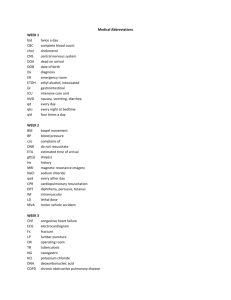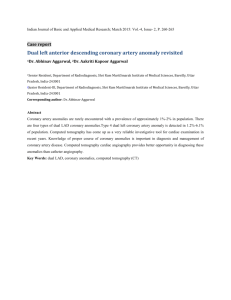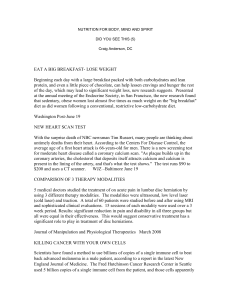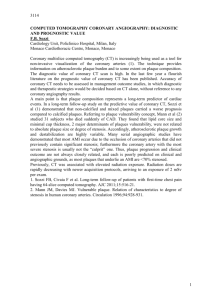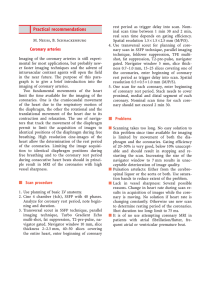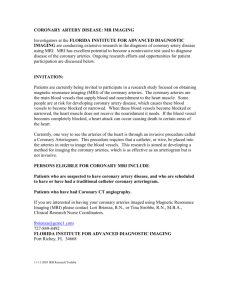Jose Punnya
advertisement
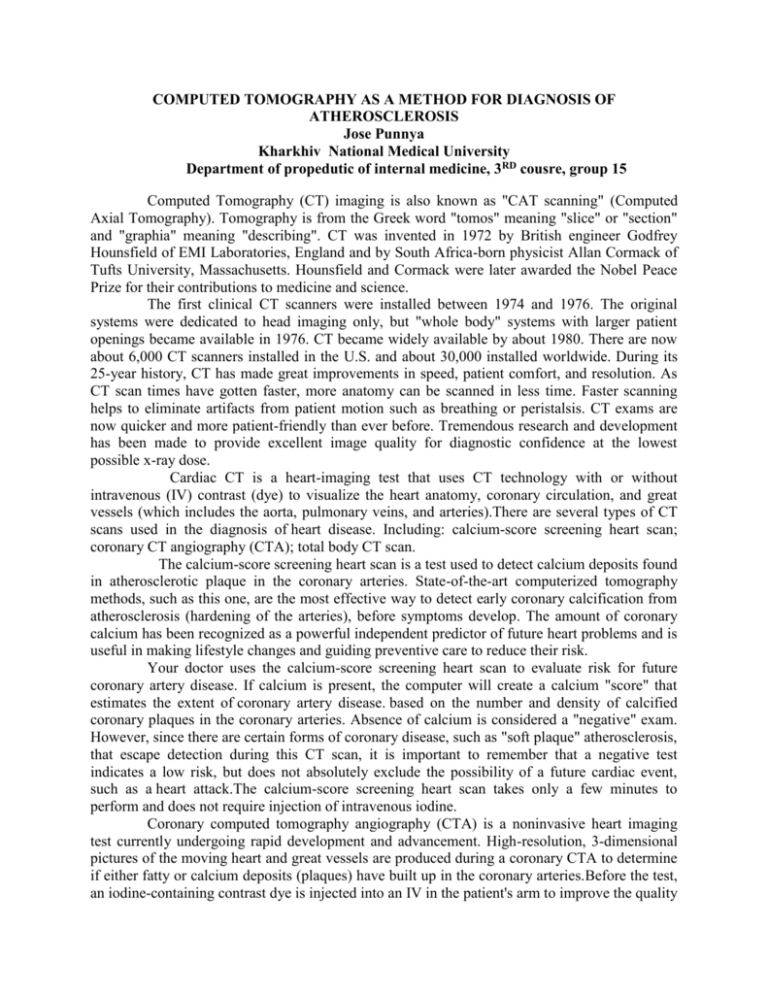
COMPUTED TOMOGRAPHY AS A METHOD FOR DIAGNOSIS OF ATHEROSCLEROSIS Jose Punnya Kharkhiv National Medical University Department of propedutic of internal medicine, 3RD cousre, group 15 Computed Tomography (CT) imaging is also known as "CAT scanning" (Computed Axial Tomography). Tomography is from the Greek word "tomos" meaning "slice" or "section" and "graphia" meaning "describing". CT was invented in 1972 by British engineer Godfrey Hounsfield of EMI Laboratories, England and by South Africa-born physicist Allan Cormack of Tufts University, Massachusetts. Hounsfield and Cormack were later awarded the Nobel Peace Prize for their contributions to medicine and science. The first clinical CT scanners were installed between 1974 and 1976. The original systems were dedicated to head imaging only, but "whole body" systems with larger patient openings became available in 1976. CT became widely available by about 1980. There are now about 6,000 CT scanners installed in the U.S. and about 30,000 installed worldwide. During its 25-year history, CT has made great improvements in speed, patient comfort, and resolution. As CT scan times have gotten faster, more anatomy can be scanned in less time. Faster scanning helps to eliminate artifacts from patient motion such as breathing or peristalsis. CT exams are now quicker and more patient-friendly than ever before. Tremendous research and development has been made to provide excellent image quality for diagnostic confidence at the lowest possible x-ray dose. Cardiac CT is a heart-imaging test that uses CT technology with or without intravenous (IV) contrast (dye) to visualize the heart anatomy, coronary circulation, and great vessels (which includes the aorta, pulmonary veins, and arteries).There are several types of CT scans used in the diagnosis of heart disease. Including: сalcium-score screening heart scan; сoronary CT angiography (CTA); total body CT scan. The calcium-score screening heart scan is a test used to detect calcium deposits found in atherosclerotic plaque in the coronary arteries. State-of-the-art computerized tomography methods, such as this one, are the most effective way to detect early coronary calcification from atherosclerosis (hardening of the arteries), before symptoms develop. The amount of coronary calcium has been recognized as a powerful independent predictor of future heart problems and is useful in making lifestyle changes and guiding preventive care to reduce their risk. Your doctor uses the calcium-score screening heart scan to evaluate risk for future coronary artery disease. If calcium is present, the computer will create a calcium "score" that estimates the extent of coronary artery disease. based on the number and density of calcified coronary plaques in the coronary arteries. Absence of calcium is considered a "negative" exam. However, since there are certain forms of coronary disease, such as "soft plaque" atherosclerosis, that escape detection during this CT scan, it is important to remember that a negative test indicates a low risk, but does not absolutely exclude the possibility of a future cardiac event, such as a heart attack.The calcium-score screening heart scan takes only a few minutes to perform and does not require injection of intravenous iodine. Coronary computed tomography angiography (CTA) is a noninvasive heart imaging test currently undergoing rapid development and advancement. High-resolution, 3-dimensional pictures of the moving heart and great vessels are produced during a coronary CTA to determine if either fatty or calcium deposits (plaques) have built up in the coronary arteries.Before the test, an iodine-containing contrast dye is injected into an IV in the patient's arm to improve the quality of the images. A medication that slows or stabilizes the patient's heart rate may also be given through the IV to improve the imaging results. During the test, which usually takes about 10 minutes, X-rays pass through the body and are picked up by special detectors in the scanner. The newer scanners produce clearer final images with less exposure to radiation than the older models. These new technologies are often referred to as "multidetector" or "multislice" CT scanning.
